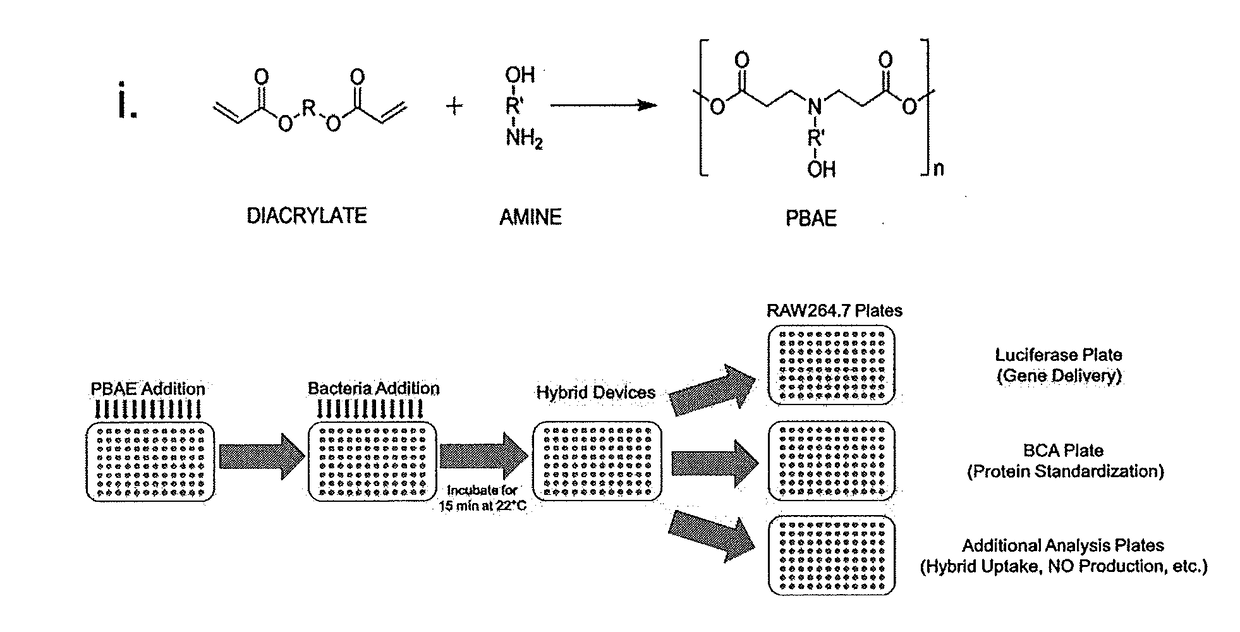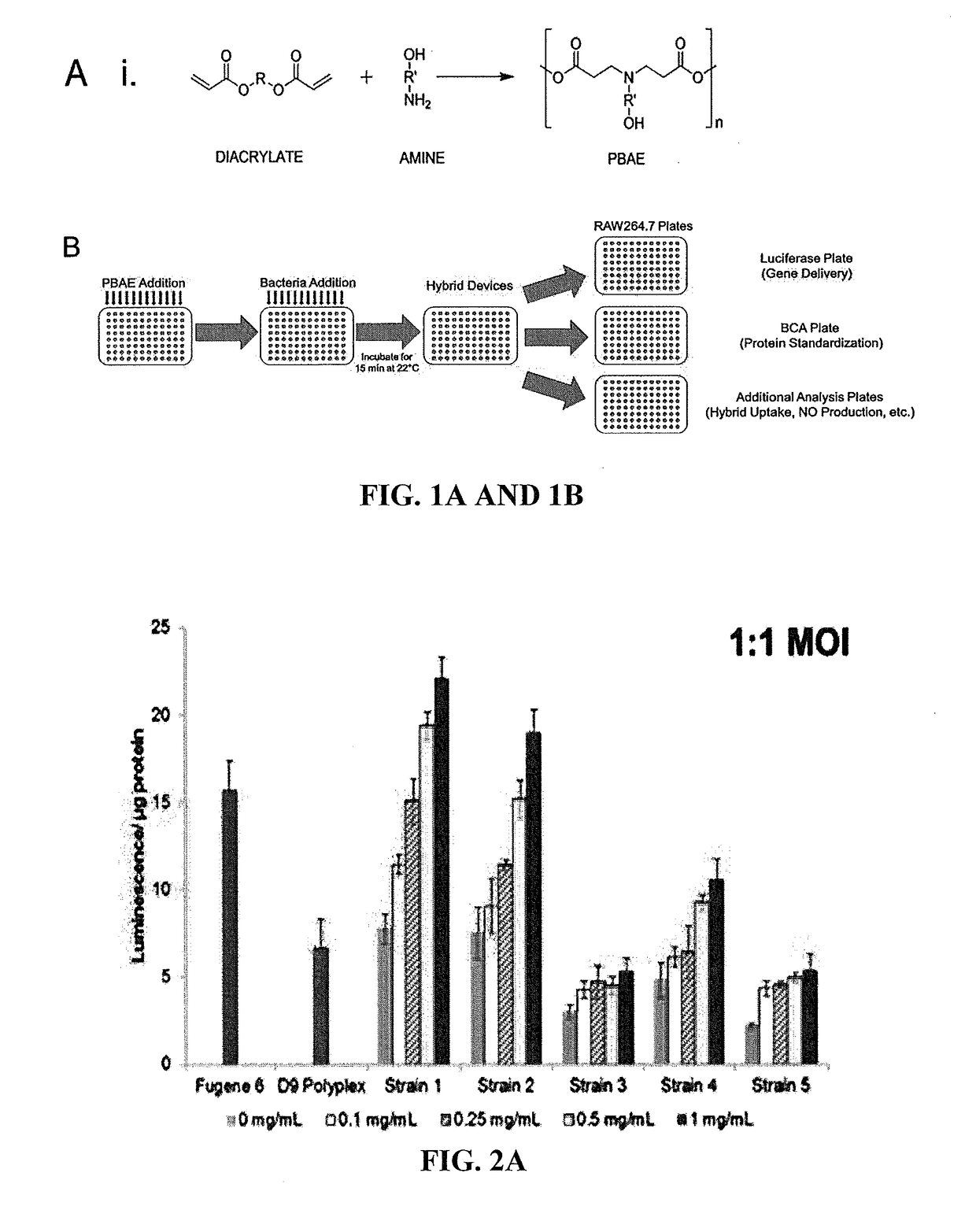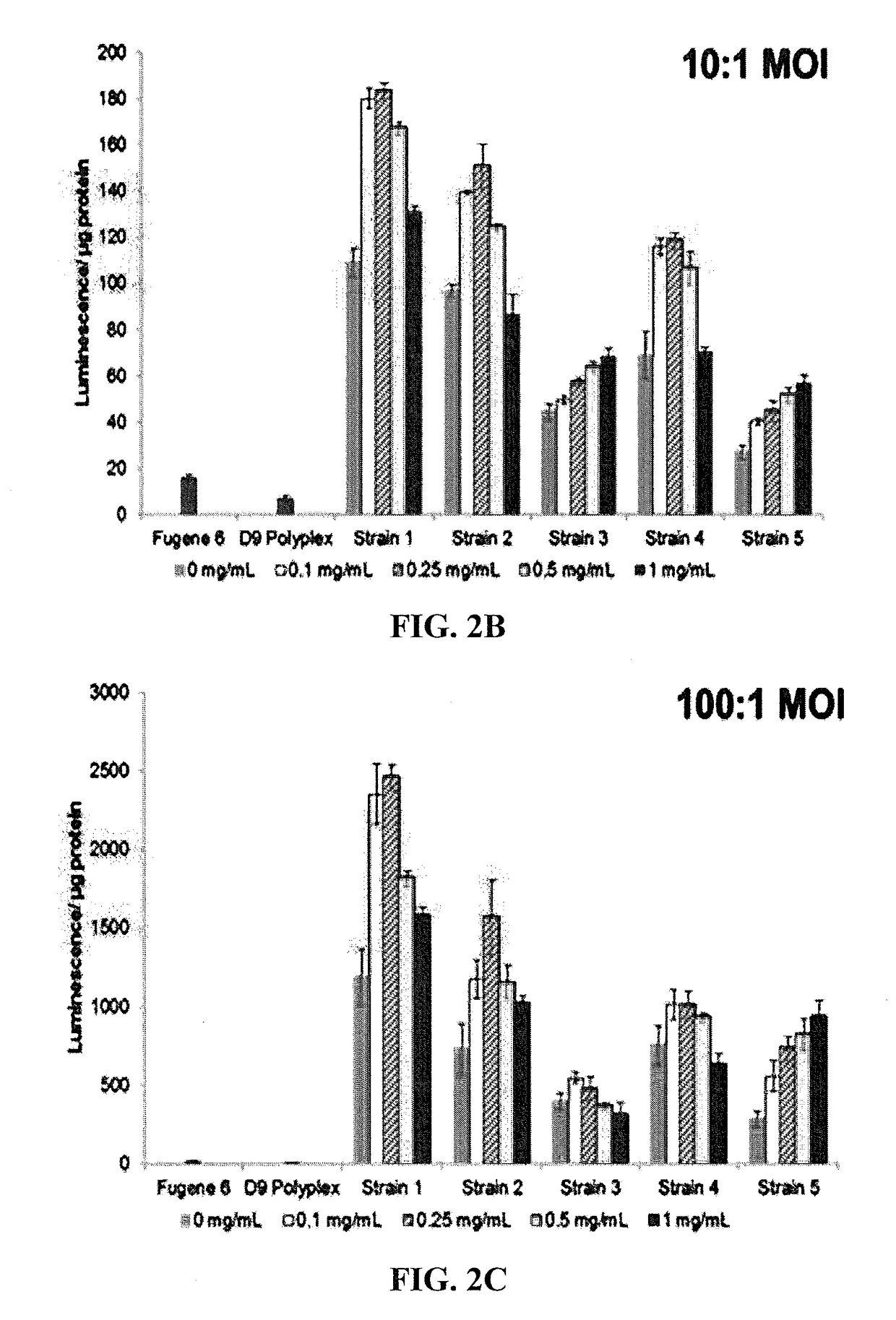System and method for delivering genetic material or protein to cells
a technology of genetic material or protein and cell, applied in the field of molecular delivery systems, can solve the problems of limited overall success, limited production capability of current approaches, and difficult to get the sirna to the proper organ/cell of interest, etc., to achieve minimal or no toxicity, facilitate uptake of hybrid bacterial vectors, and reduce the effect of toxicity
- Summary
- Abstract
- Description
- Claims
- Application Information
AI Technical Summary
Benefits of technology
Problems solved by technology
Method used
Image
Examples
example 1
Hybrid Vectors Including Acrylate-Terminated Poly(Neopentyl Glycol Diacrylate-Co-2-Amino-1,3-Propanediol) Enhance Delivery of Nucleic Acids to APC
Materials and Methods
[0302]Preparation of Bacteria / Polymer Hybrid Vectors.
[0303]Bacterial and hybrid vectors were prepared from bacterial cultures inoculated at 2% (vol. / vol.) from overnight starter cultures. Plasmid selection antibiotics were used as needed during bacterial culture within lysogeny broth (LB) medium. Following incubation at 36° C. and shaking at 250 rpm to an optical density at 600 nm (OD600) of between 0.4 and 0.5, samples were induced with 0.1 mM Isopropyl β-D-1-thiogalactopyranoside (IPTG) for 1 hr at 30° C. Bacteria cells for use in control samples were washed once and standardized to an OD600 value of 0.5 in PBS.
[0304]Bacteria cells to be used in hybrid vector formation were washed once and standardized to an OD600 value of 1.0 in 25 mM NaOAc (pH 5.15).
[0305]Cationic polymers (CP) were dissolved in chloroform, desicca...
example 3
Polymers Beneficially Attenuate the Bacterial Core
Methods
[0379]Induced bacterial culture and hybrid vector samples (200 μL) were washed and resuspended in PBS, before being sonicated at 20% capacity for 5 seconds using a Branson 450D Sonifier (400 Watts, tapered microtip).
[0380]Sonicated samples were plated on LB agar plates and incubated for 24 h prior to counting colony forming units.
Results
[0381]The coating of CPs to the bacterial surface was initiated to increase the surface charge of final hybrid devices (FIG. 3B). The increased charge may aid the electrostatic attraction to mammalian cells and facilitate subsequent uptake.
[0382]The surface coating may beneficially attenuate the bacterial core of the hybrid device. To test this possibility and expand upon the reduced cytotoxicity afforded by D9 surface additions (FIG. 2D), hybrid vectors were tested in shear disruption studies conducted through brief exposure to sonication (FIG. 3C).
[0383]Without sonication, hybrid vectors demo...
example 4
Polymer Coating Density Influences Bacterial Uptake
Methods
[0384]Characterization of Hybrid Devices
[0385]Zeta potentials of bacterial, polymer, and hybrid vectors were measured by DLS. To measure surface hydrophobicity of bacteria before and after PBAE additions, samples were analyzed using a modified microbial adhesion to hydrocarbon (MATH) assay (Pack, Lynn). Briefly, bacterial and hybrid vectors were prepared and resuspended in PBS to a final OD600 value of 1.0. One milliliter of bacterial or hybrid vector was added to a clean glass tube in addition to 110 μL of n-hexadecane (10% v / v). Each sample was then vortexed for one minute at setting 10 (Analog Vortex Mixer, Fisher Scientific) and allowed 5 to settle for 15 minutes for phase separation.
[0386]Using a clean Pasteur pipet, bacterial / hybrid vector solution was retrieved, taking care to avoid the upper hydrocarbon layer, and transferred to a cuvette for a final OD600 measurement. The percentage change of hydrophobicity is calcul...
PUM
 Login to View More
Login to View More Abstract
Description
Claims
Application Information
 Login to View More
Login to View More - R&D
- Intellectual Property
- Life Sciences
- Materials
- Tech Scout
- Unparalleled Data Quality
- Higher Quality Content
- 60% Fewer Hallucinations
Browse by: Latest US Patents, China's latest patents, Technical Efficacy Thesaurus, Application Domain, Technology Topic, Popular Technical Reports.
© 2025 PatSnap. All rights reserved.Legal|Privacy policy|Modern Slavery Act Transparency Statement|Sitemap|About US| Contact US: help@patsnap.com



